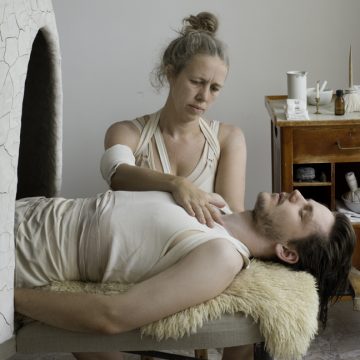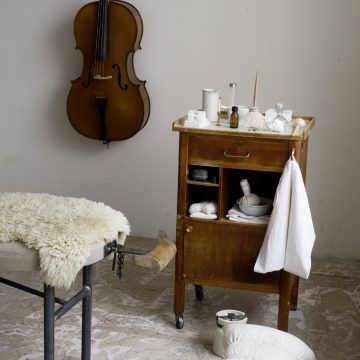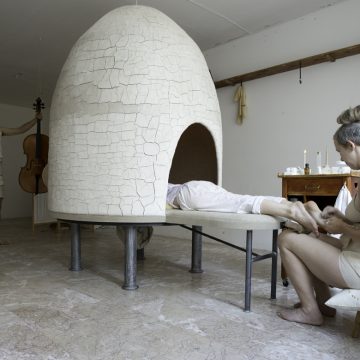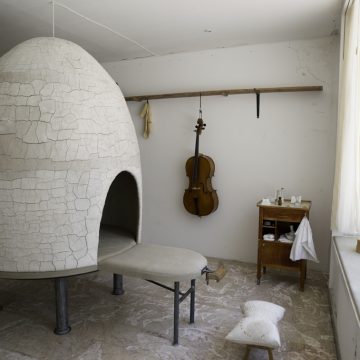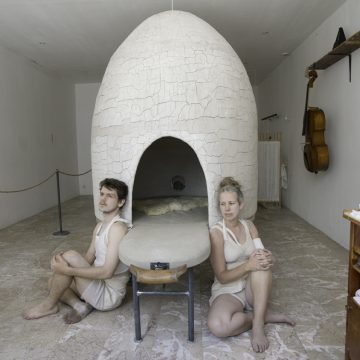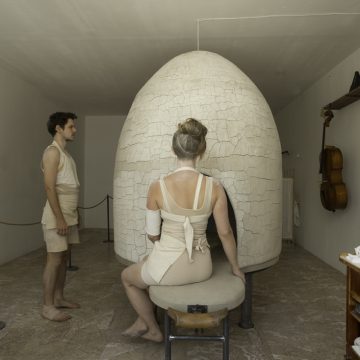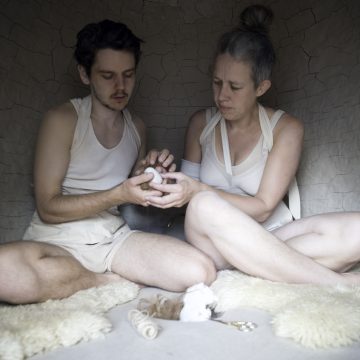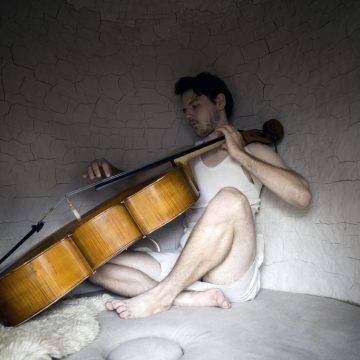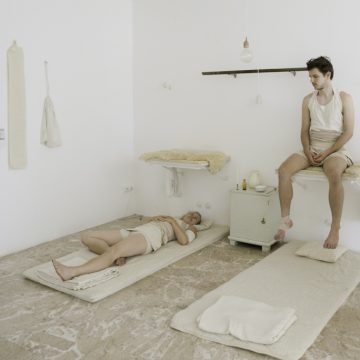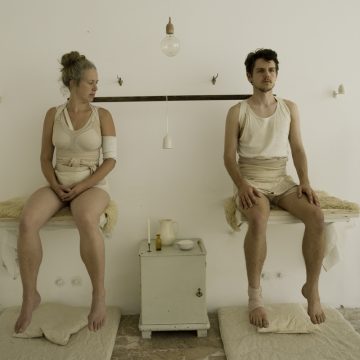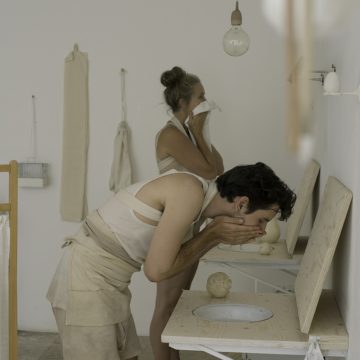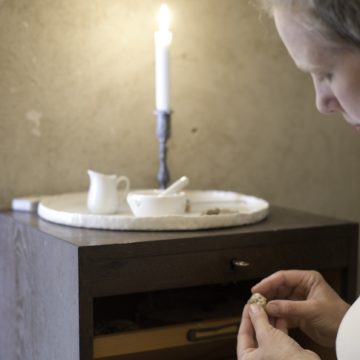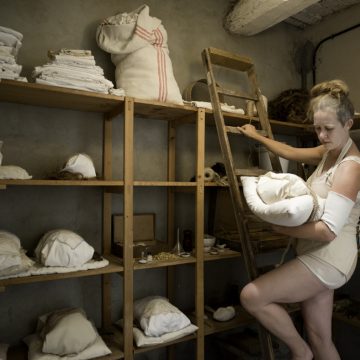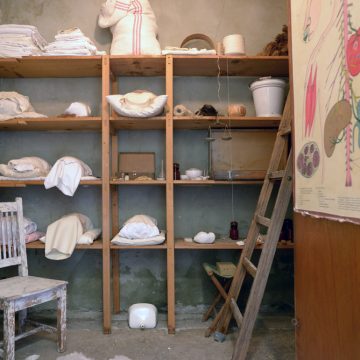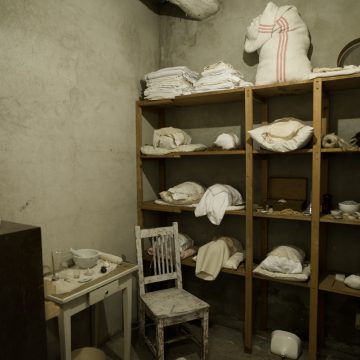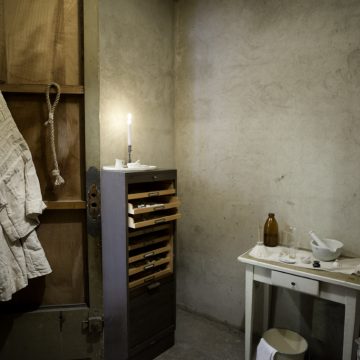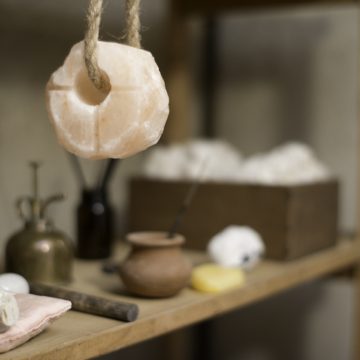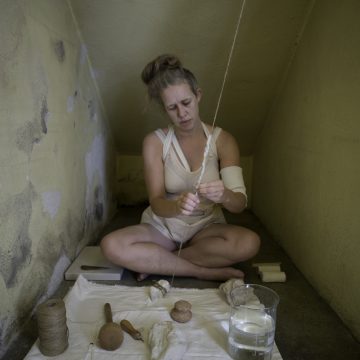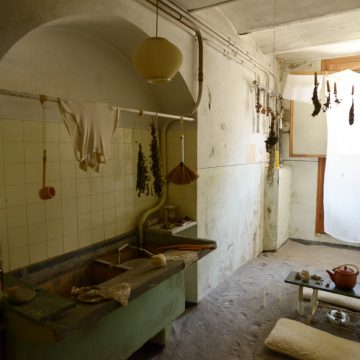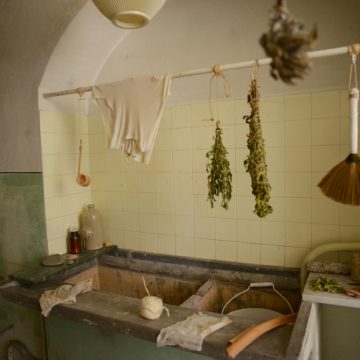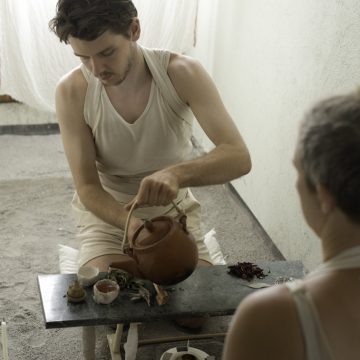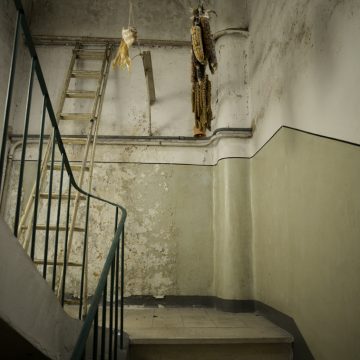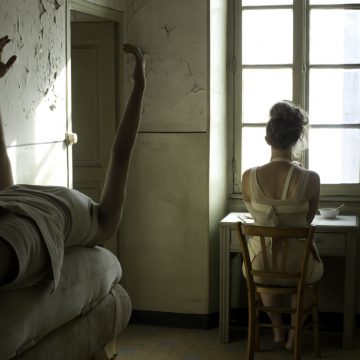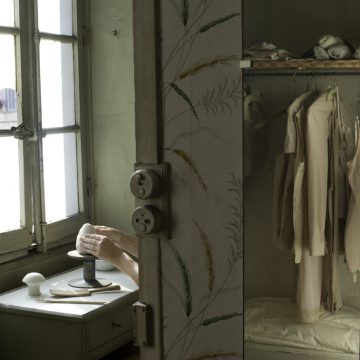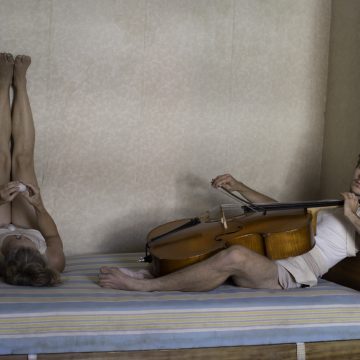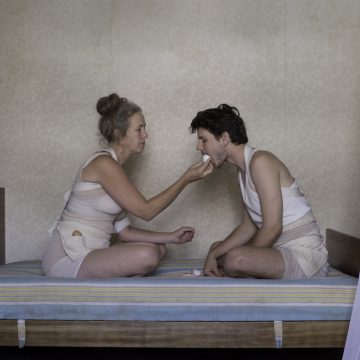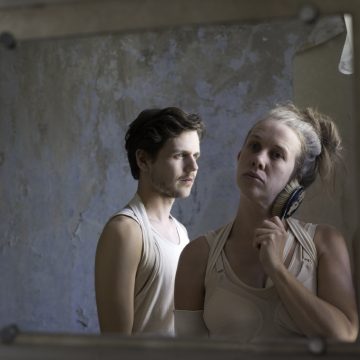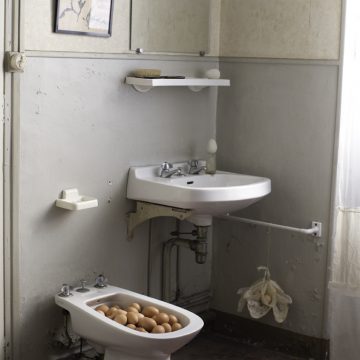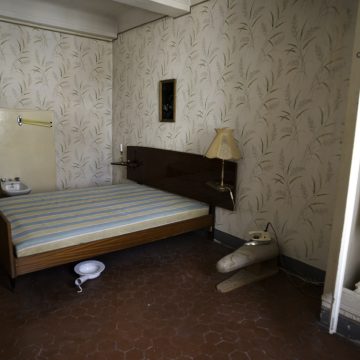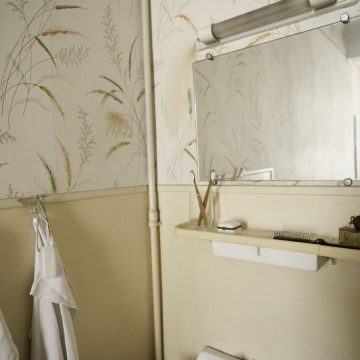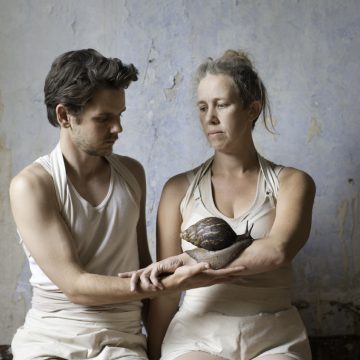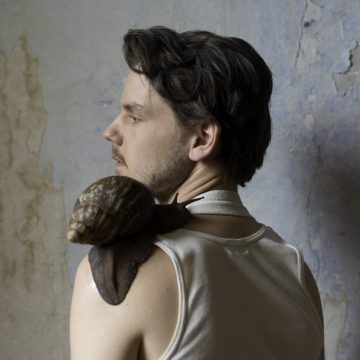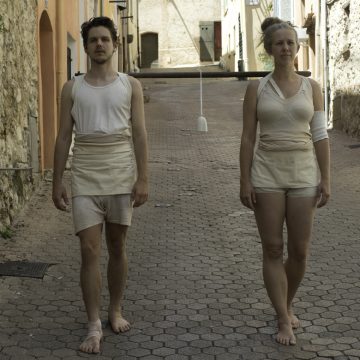Catalog text
Danish/Swedish ceramic artist Christin Johansson’s work goes through her body. It is the meeting between physical body and raw, moldable material that interests her. How does it create experiences of humanness, of existence, of connection and consciousness?
The juxtaposition in itself is very interesting. Consciousness and subtle, energetic experiences draw on inward, personal and non-physical sensitivities that would normally be a direct opposite to the physicality and object character of ceramics. But in Christin Johansson’s work there is no opposition. Physicality is a doorway to experiencing what is not physical. It is a way to take us beyond the cognitive framework of the mind, behind the material world as we believe it to be, and into a non-verbal, felt experience of deeper consciousness.
In a way this is what Christin Johansson has always done. Since she was a child, she knew that her body had a greater wisdom than her mind. She would experience the world through sensations that she could not always express in words, and the linear thinking of the schooling system would appeal to her much less than aesthetic and physical expression. By almost random chance she decided to train as a medical nurse, and although it appears like a deviation from an early calling for an artistic path, the years as a nurse brought her an immensely important experience. Working at the Hepatology ward with patients facing serious health threats opened up a sensitivity to existential questions of life and death. She witnessed deep, human experiences that made her reflect on her own life in a different way. Despite her young age at this point, she had a growing sense that she was much older than this lifetime. There was more to life than our everyday consciousness and our linear experience of time. It woke up a calling to listen to these impulses and engage with life from a deeper place of meaning. There was something she needed to embody, and seeing how quickly and unexpectedly life can be over, she decided to follow a dream of creative expression that was forming in her.
Christin Johansson found the answer in the clay. In addition to her working life she started experimenting with clay at a local art center, and soon she found herself training at an art academy, where she fortunately met ceramic artist Anne Nielsen, who on a synchronous side note exhibited at Vallauris 35 years ago! This meeting became crucial for Christin Johansson, who found a mentor in Anne Nielsen that would guide her fully onto her artistic path. She ended up leaving the medical world behind and entering a professional training in ceramics at the Glass and Ceramic School at Bornholm. From here her journey entered a new level. Soon it became obvious that artistic expression was her calling, clay was her medium and the embodied experience of meetings and connections was her raw material.
In the beginning she addressed this tentatively. Like so many other ceramicists she learnt to make functional forms, and kept object-based social interactions as an almost parallel stream of work. Gradually the two started aligning: functional forms would become objects, objects would become space, and space would create interactions. This is where Christin Johansson found her artistic identity, in creating meetings, sensations, perceptions that would transcend the normal subject/object relationship of ceramic art. Projects as Found in China (2007), Claymobile (2009) and Letters for the Danes (2011) are some of the highlights from these recent years, as her artistic practice started to come into maturity. Though, with the major project Her Alter Ego Universe (2012), for which she received a prestigious 3 years work grant from the Danish Art Foundation, her expression would gain an essential addition: She changed her role from engaging with the public in the role of herself as an artist and facilitator, detached from the artistic content so to say, and into the role of a performer, embodying an identity different from her professional self. In this project she suspended conventional thinking and allowed herself to be guided by pure intuition. What emerged was the identity of a woman, Augustine Adler, who appeared to be a past life identity, living in Dresden in the 17th century. An overwhelming amount of details helped recreating this identity into a full gesamtkunstwerk with physical surroundings, objects, clothes and behavior. Christin Johansson performed the identity of Augustine in the installation, engaging with the public in different ways but completely connected to this alter ego. Her ability to let herself enter what appeared to be an altered state of consciousness was striking, and marked a shift in her artistic career. More than ever she became the medium. She allowed the artistic impulse to flow through her, not just into the creation of an object or situational environment, but into her own body and consciousness.
This ability to open to impulses from intuition and deeper consciousness took Christin Johansson into an interesting reconnection with aspects of her old medical profession. In 2015 she decided to do a professional training in craniosacral therapy. This is a healing modality that works with rebalancing the nervous system and physical contraction through different ways of touch, gentle physical manipulation and breath. Here she got an experience of consistently coming out of the mind and into the body, and learning to listen to the subtle language of non-verbal experiences that transcend cognitive understanding, from a place of deep relaxation and presence.
In this way she shaped her own body and consciousness to be an even more precise artistic instrument for the creative flow of life that runs in her so strongly.
As things sometimes work synchronously when important shifts are happening, Christin Johansson met video artist, performer and contemporary dancer Peter Scherrebeck Hansen. His approach to artistic expression is equally through embodiment and full presence in the now. Amongst others he trained in somatic movement, contact improvisation and Butoh dance, which demands a heightened awareness of what is moving in the body, moment to moment. It creates a sensuous, intuitive, non-verbal rather that a chronological narrative. What is left is the raw, honest physical expression of the present moment. Having played the cello since he was 10, music is also an integral part of his expression, which we see in the present project.
Together, Christin Johansson and Peter Scherrebeck Hansen found an almost alchemical connection of shared interest in the space of embodied presence as artistic expression. Both being performers who see their practice as allowing life itself to run through them, it was clear that between them they could create a synthesis that could take both of them into a new place. Christin Johansson therefore decided to invite Peter Scherrebeck Hansen to join her for the Vallauris Biennale in 2016. Between them they have created a physical and energetic space where bodies can open in trust. It is a performance and an experiential space for the spectator as much as an inner experience for both of them. What happens if they create space and conditions for being fully present, body to body, body to clay, consciousness meeting physicality, 24 hours a day for a week, in a non-verbal exchange of presence and intention? And what happens when they have spectators enter this internal and deeply vulnerable, intimate space that they create? When the culturally imposed filters of identity disappear, and being in the moment is all that is left.
Situated in an old barbershop that Picasso frequented during his productive years in Vallauris, Christin Johansson and Peter Scherrebeck Hansen will inhabit the interior and turn it into their living space for one week of the exhibition period. Building an enormous egg from wickerwork and clay, they will create a sacral space for healing and nurture. Spectators are invited into the room, silent and bare feet, where only a thin curtain creates a membrane between the artists’ silent, sacral space and the mundane space of the spectator. Christin Johansson will offer craniosacral healing and perform different rituals using clay, while Peter Scherrebeck Hansen, amongst others will create healing vibrations by playing the cello. In this way they transform the barbershop into a doorway leading the spectator to a deeper meeting with themselves. A reality where most of the conventions and habits of human life are stripped away, leaving only the essentials: presence and embodiment.
The story that Christin Johansson is telling is multifaceted and multilayered. Each of the original rooms in the back of the house and upstairs have been given a meaning and a function. There are rooms to rest and nurture the body and rooms to store, prepare and care for the clay that they will use when performing. These rooms are the inner sanctuary of the artists. This is where their energy is replenished and where they prepare for the sacral tasks that are carried out in the space accessible for the public. On special occasions a spectator might be invited into these sacred, intimate rooms, but mostly they are for the artists alone. It is from this inner sanctuary that they will bring their full presence and embodiment into the public space. Praying, meditation, playing the cello or physical exercise takes place here, all in order to prepare them for the act of service that is their performance.
The artists have something of great importance to give to the public. It is created between them and flows through their bodies. They can only access it by aligning energetically with each other, with their deeper consciousness, and by interacting with the clay in ways that makes them drop into the reality of their bodies. It is energetic, connective and physical at the same time, thus building a bridge between consciousness, energy and physicality. Individuality, identity and separateness slowly erode as they enter this space of transcendence, and they can only do that by being completely attuned, like an instrument, to the clearest of energetic frequencies.
Their aim is to convey this feeling to the public, for the spectators to find a similar place in themselves. It is not a performance to be processed and ‘understood’ from the rational mind, and especially not from a perspective of an art theoretical context. There is nothing to understand, it is about bringing the spectators into their own body and to enter this silent place in themselves. In this way Christin Johansson and Peter Scherrebeck Hansen are acting like ‘the strongest pendulum in the room’: By holding this energetic frequency in themselves, undisturbed by the mental and emotional intensity of the everyday world that the spectators bring, they can emit this embodied silence and slowly wake it up in others. It is a purely experiential and intuitive space that they’re offering. The rational, categorizing mind has no place. It is about waking up energy that is locked away behind layers and layers of thinking, cultural conditioning and personal histories of fear and pain, layered as armouring and tension in our bodies.
As Christin Johansson herself describes it, Peter Scherrebeck Hansen and her are deeply connected in love at soul level, as brother and sister in a spiritual family, with a mission of awaking to a deeper level of consciousness through embodiment. By this Christin Johansson as an artist offers a role for art that is part of a new, emerging paradigm. Art is so deeply engaged in life that it becomes a transformational ritual, a rite of passage between layers of human consciousness. Christin Johansson is not performing ‘art’, she is creating conditions for Life itself to flow through her. At this point in history of humanity we are faced with economical, ecological and human challenges that severely question our truth, values and lifestyle. We do need to find the answers outside the known, outside our existing paradigm of our everyday reality. We have to look deeper and higher, into the unknown.
This is what art has always represented, as long as we have adorned our own skin, tents, caves, pottery; as long as we have used images and patterns to evoke mystical powers beyond the known. On the evolutionary edge, this is a final goodbye to the isolation of art in modern era, and a coming back to art as the source and access point to deeper life itself.
Louise Mazanti
Ph.D in contemporary craft theory
